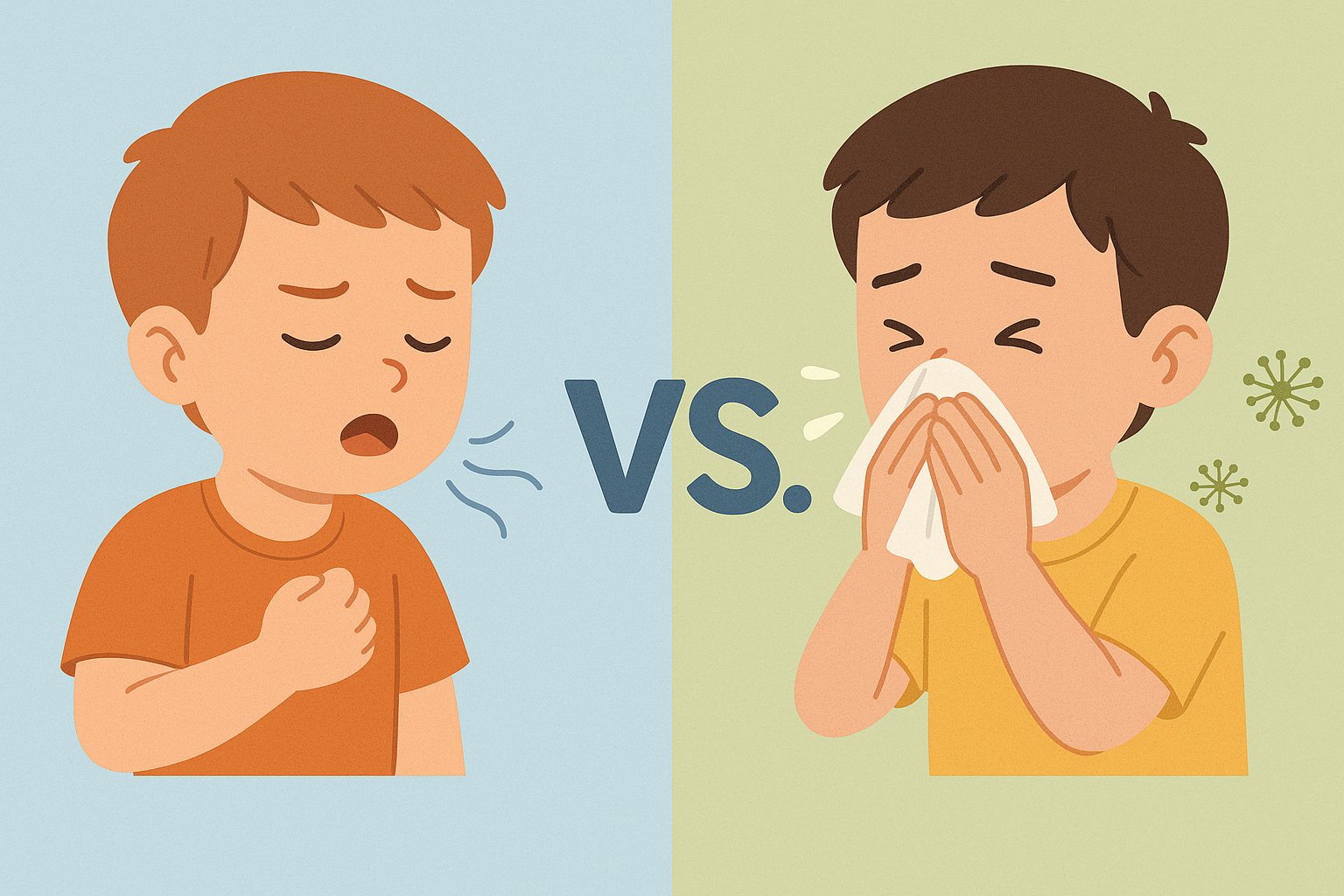As a parent, seeing your child struggle with incessant coughing, sneezing, or shortness of breath can be distressing. Two of the most prevalent conditions responsible for these symptoms among kids are asthma and allergies. Though they usually share similar symptoms and triggers, they are different conditions. Knowing their differences—and how they’re related—will aid you in better managing your child’s health.
In this blog, we will be answering crucial questions such as “How do you know if your child has allergies or asthma?”, “How to tell the difference between asthma and allergy?”, and “Are allergies and asthma connected?” We will also discuss how to differentiate between asthma and allergic rhinitis.
What Is Asthma?
Asthma is a long-term respiratory disease that triggers inflammation and bronchoconstriction of the air passages of the lungs. This produces symptoms such as:
- Wheezing
- Breathlessness
- Chest tightness
- Coughing (particularly at night or in the early morning)
These symptoms are likely to change in severity and can be brought on by a range of factors including exercise, cold air, respiratory viruses, and allergens like dust mites, pollen, or pet dander.
What Are Allergies?
Allergies are the result of the immune system overreaction to a harmless substance (allergen) like pollen, mold, pet dander, or food. The typical allergic symptoms in children are:
- Sneezing
- Stuffy or runny nose
- Itchy, watery eyes
- Skin rashes (eczema or hives)
- Digestive problems (if it’s an allergy to food)
Allergies may occur in various parts of the body and are not restricted to the respiratory system.
How Do You Know If Your Child Has Allergies or Asthma?
This is a question for many parents: How do you know if your child has allergies or asthma? The key lies in knowing the patterns of symptoms, triggers, and timing.
Indications that your child has asthma:
- Frequent coughing, particularly at night
- Coughing or wheezing while playing or exercising
- Respiratory distress that gets worse with cold air or allergens
- A sense of tightness in the chest
Indications that your child has allergies:
- Sneezing attacks
- Runny nose or nasal congestion
- Red or itchy eyes
- Skin issues after exposure to allergens (like touching a pet or eating specific foods)
If your child experiences both sets of symptoms, it’s possible they have both allergies and asthma, which is quite common.
How to Tell the Difference Between Asthma and Allergy?
How to tell the difference between asthma and allergy? While asthma and allergies often coexist, the key differences lie in where the symptoms occur and how the body reacts.
| Feature | Asthma | Allergies |
|---|---|---|
| Affected System | Respiratory (lungs) | Immune response (various organs) |
| Main Symptoms | Wheezing, breathlessness, chest tightness, chronic cough | Sneezing, itchy eyes, skin rashes, nasal congestion |
| Triggers | Allergens, cold air, exercise, infections | Allergens (pollen, food, pets), insect stings |
| Duration | Chronic, with periodic flare-ups | Can be seasonal or year-round |
Understanding these differences helps in accurate diagnosis and management.
Are Allergies and Asthma Connected?
Are allergies and asthma connected? Yes, the connection between allergy and asthma, particularly in kids, is highly relevant. As a matter of fact, the most prevalent condition of asthma among children is allergic asthma. The latter is due to allergens such as animal dander, pollen, mold, or dust mites.
Kids suffering from allergic illnesses such as eczema or hay fever (allergic rhinitis) have a tendency to develop asthma down the road—a process, by the way, sometimes labeled the “atopic march.”
Therefore, if your child already suffers from allergies, it’s essential to watch for early signs of asthma. Properly managing allergies can sometimes minimize the severity or frequency of asthma attacks.
How to Differentiate Between Asthma and Allergic Rhinitis?
How to differentiate between asthma and allergic rhinitis? Allergic rhinitis (also referred to as hay fever) and asthma have similar triggers but are distinct conditions:
Allergic Rhinitis:
- Involves the upper respiratory tract (nose and sinuses)
- Symptoms are sneezing, stuffy nose, runny nose, and watery eyes
- More pronounced in certain seasons or after exposure to allergens
Asthma:
- Influences the lower respiratory system (lungs)
- Produces shortness of breath, wheezing, and coughing
- Often worsens during nighttime or exercise
Homeopathic Treatment: A Gentle, Natural Solution
In the case of childhood asthma and allergies, parents are increasingly going to homeopathy for a safer, longer-lasting cure. Homeopathy heals the child as a totality, with the aim of enhancing the immune system, suppressing hypersensitivity, and cutting down recurrence of symptoms without side effects. In contrast to allopathic treatments that depend on suppressants or steroids, homeopathy employs highly diluted natural remedies to activate the body’s self-curing mechanism.
Dr. Rashmi Chandwani, a well-known homeopathy expert, has successfully cured many cases of childhood asthma and allergies. Her customized approach is to know each child’s individual constitution, triggers, emotional profile, and health history. Children have not only felt better from symptoms under her care but also had long-term improvement in overall health and immunity. Her commitment to natural healing has made her a trusted name among parents looking for gentle, yet effective alternatives to conventional treatments.
Diagnosis: Getting the Right Help
If you’re unsure whether your child has asthma, allergies, or both, consult a qualified homeopathic doctor. Diagnosis typically involves:
- Medical history review
- Physical examination
- Allergy testing (skin prick or blood test)
- Lung function tests (spirometry or peak flow test)
Homeopaths, such as Dr. Rashmi Chandwani, tend to delve into emotional and behavioral tendencies, lifestyle, and environmental situations in order to reach a holistic diagnosis—something regular medicine could miss.
Home Management Tips
- Utilize air purifiers to minimize indoor allergens.
- Keep pets out of your child’s bedroom.
- Wash bedding in hot water every week.
- Check pollen counts and keep windows shut on high pollen days.
- Stay away from smoking in the presence of children—it’s a chief asthma and allergy inducer.
Homeopathy pairs perfectly with lifestyle adjustments, working internally to achieve long-term equilibrium for a child’s immune and respiratory systems.
When to Consult with a Physician
Consult your doctor if your child:
- Experiences frequent coughing or wheezing spells
- Must use a rescue inhaler more than two times a week
- Has difficulty breathing at night or while exercising
- Develops symptoms of allergic reactions such as rashes, swelling, or gastrointestinal distress
In these instances, visiting a homeopathic professional such as Dr. Rashmi Chandwani may provide a pain-free, productive solution.
Conclusion
Asthma and childhood allergies are distinct in their effects on the body but tend to go hand-in-hand and also have an influence on one another. Knowing what to look for in terms of symptoms, understanding how to tell the difference betweenasthma and allergy, and treating both as a set through proper diagnosis and treatment is vital to your child’s future well-being.
If you’re looking for a treatment that not only eliminates symptoms but addresses root issues as well, homeopathy is an avenue worth considering. Under experienced guidance from clinicians like Dr. Rashmi Chandwani, your child can look forward to healthier, more balanced living—unencumbered by the vicious cycle of suppressive drugs and repeated flare-ups.




